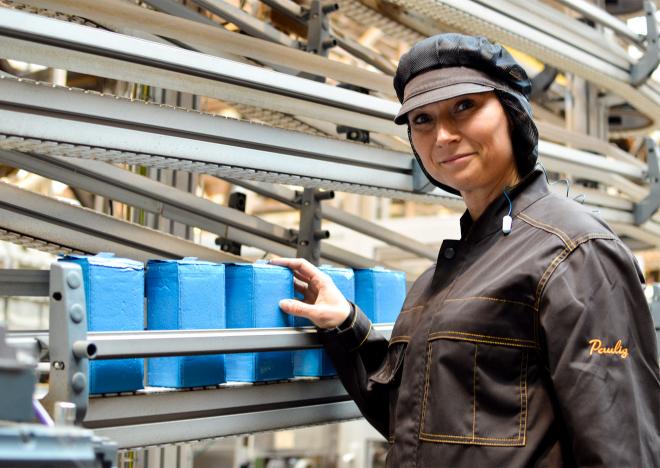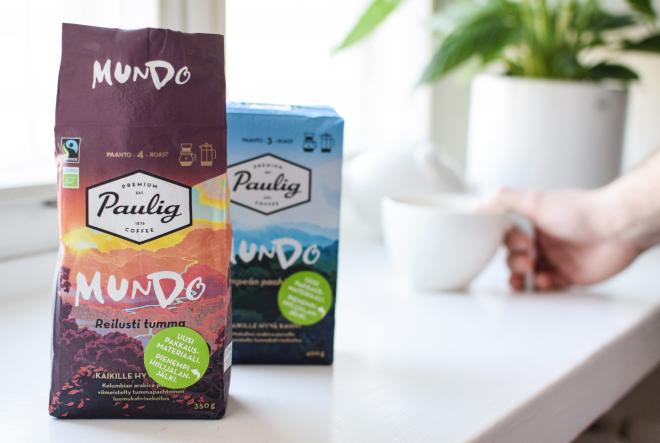Kati Randell, Strategic Packaging Development Manager for Paulig drinks, rejoices about the fast development of packaging materials every day in her work. “Currently, the possibilities of making plastic directly from carbon dioxide are, among other things, being studied. It would be great if this were to succeed,” says Randell. We asked her 10 questions about packaging innovations.
What is the first thing you do when arriving at work in the morning?
“I usually start with the most important work I have to do, which I have written down. I also check any possible important, urgent e-mails. In the winter, the first thing I do is turn on the bright light lamp. And the very first thing, every morning, is get a cup of coffee.”
What is a typical working day like for you?
“There is no such thing. My working days include meetings, planning, reading the latest research, meeting with suppliers of raw materials and packaging and studying samples. My work consists largely of studying the latest data and planning together with suppliers and colleagues how we could apply that data.”
What is the direction in which Paulig is currently developing its coffee packaging?
“The perspective of sustainability is very strongly present in development work. Paulig’s goal is that by 2025 all our coffee packaging is made of plant-based, renewable, fossil free materials. This is a challenging goal but we move determinedly towards it. In 2019, part of Paulig coffee packages are already made of 50% bio-based, renewable, fossil free materials. By increasing the amount of renewable materials in our coffee packages we have been able to decrease the carbon footprint of the package by one third. We have selected bio-based materials for our coffee packages instead of biodegradable because the former have a smaller carbon footprint.”

What has been the biggest leap in recent years when it comes to innovations?
“Not having to use only fossil-based plastic in packaging – we also use plant-based plastic and we’re looking into waste‑based options, too. The genius of the latter is that they don’t increase the amount of new carbon in the atmosphere, whereas fossil raw materials always bring out more carbon from the depths of the earth into our atmosphere. Today, the word ‘plastic’ covers both plant- and waste-based plastic as well as fossil plastic that is made from oil. This is confusing because their carbon footprint is very different.”
What problem would you like to solve right now?
“People around the world think that the marine plastic problem would be solved if all plastic was recyclable or biodegradable. However, a major part of plastic could already be recycled so it shouldn’t be in the oceans in the first place. ”Biodegradable” only means that the material gradually degrades by microbes but it does not necessarily compost even in an industrial compost. Much less in nature or in the ocean. What we need is infrastructure for processing packaging and understanding that packaging shouldn’t be disposed of in nature. Developing packages is an important issue. However, as we can see from the current state of affairs, that alone doesn’t solve the problems – infrastructure and the attitude and training of consumers do.”
Describe what working in strategic packaging development is like in practice. What guides it?
“Our packaging development is guided by the company’s strategy, consumer needs and trends related to packages and the latest material development. When the future direction has been decided, together with sourcing we update the network with which we cooperate. Finding partners is especially important. I have also participated in international seminars where I’ve spoken about our 2025 goal, communicated it on social media and been open about the fact that we are willing and capable of trying new things. In this way, raw material and packaging suppliers have also contacted us. We engage in close cooperation with our current suppliers. We want to understand the entire value chain of coffee, from raw material suppliers to cup: What kinds of opportunities and limitations does the world around us offer?”
What inspires you in your work?
“I get a lot out of my work. I’m excited about new materials and the methods used to make them. The feeling that I can actually affect the carbon footprint is an important matter to me. Packaging matters. Paulig was the first company in the world to introduce renewable raw materials to vacuum coffee bags. No other company had done that before us.”
What is it about packages that fascinates you?
“They are constantly developing. Just when you think you know everything there is to know about it, you suddenly face another new challenge or opportunity. I think that packaging isn’t a necessary evil but a necessary good. Studies show that packages can significantly reduce food waste, which is a huge global problem. If packaging is made out of renewable raw materials – or waste or waste streams in the future – it doesn’t add any fossil carbon to the atmosphere. And if it is processed correctly at the end of the chain, it won’t place a burden on nature. This means food waste can be avoided and food can be delivered to consumers with good quality and just as it was prior to packing.”
“Our recent study showed that packaging makes up only one to two per cent of the entire coffee chain’s carbon footprint. Therefore, if you make two per cent more coffee than you drink, it affects the carbon footprint more than the packaging. Also, whereas the extra coffee goes down the drain, the empty packaging can be utilized when it is placed in plastic recycling. If there is no bin for plastic waste nearby, coffee packages can also be used as a good source of energy when put in mixed waste. Mixed waste collected from consumers no longer ends up at landfills.”

What are the current prevalent packaging trends? What is coming up?
“In addition to sustainability, there is user-friendliness and easiness. The package must be easy for the consumer to use. They must also know what to do with the package after it has been used. Packaging cannot be a problem. It shouldn’t cause a guilty conscience but a good conscience.”
What kinds of recycling trends do you see in the future?
“Chemical recycling is interesting. Will it make a breakthrough and when? With chemical recycling, plastic is no longer mechanically recycled but decomposed to the starting materials aka monomers and used for new raw material. This is the subject of a lot of research right now. I believe that this is going to happen at some time and it will open up massive opportunities. But this won’t work if people don’t sort the packages in waste sorting stations.”
Kati Randell
- Occupation: Strategic Packaging Development Manager for Paulig drinks
- Career: Kati Randell has worked at Paulig since August 2016. Before that, she worked at Fazer for 10 years and before that for approximately 10 years at Valio in packaging development. Early in her career, Randell was a researcher at VTT Technical Research Centre of Finland.
- Education: Master of Food Sciences
- Hobbies: fitness boxing and dancing
- Motto: “Don’t let setbacks get you down, learn from them instead.”
See the video how Paulig coffee packaging has developed during past years: